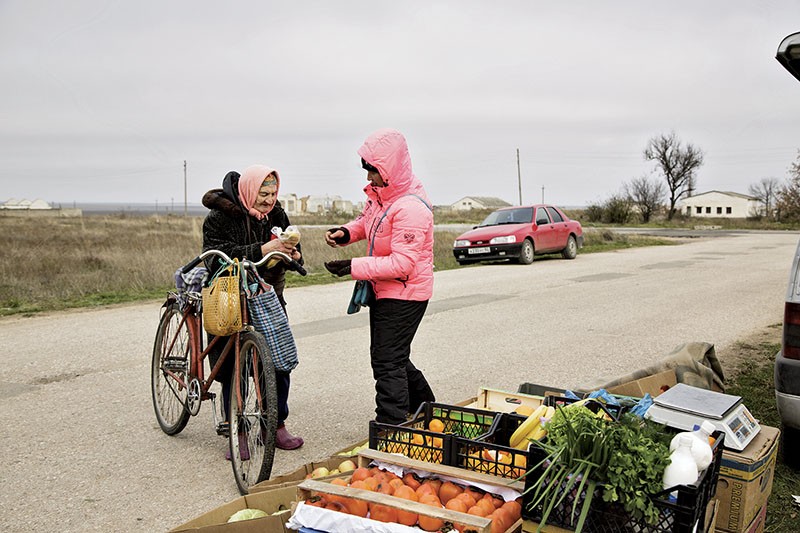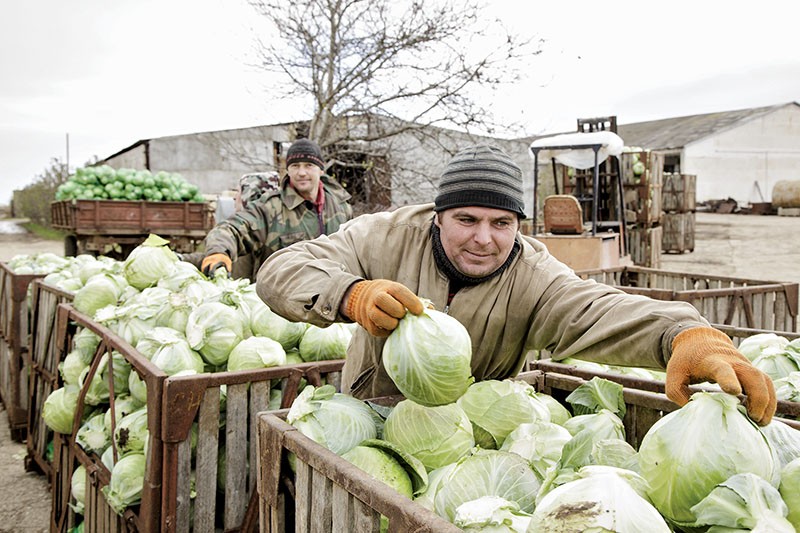PERVOMAISK, CRIMEA — The Kalinina farm collective near Pervomaisk in northern Crimea is busy with seasonal workers loading sacks of cabbages, or gathering up carrots in the big muddy fields. It looks like a successful harvest, but it’s a result of almost three years of hard struggle to adapt to new conditions here, after vital water supplies from Ukraine’s mainland stopped in 2014, following Russia’s annexation of Crimea.
“Now we have to lay out these maggots,” said farmer Vladimir Vasilievich, kicking a huge roll of plastic piping which snakes all over his carrot fields, providing a drip irrigation system which has to be replaced every two seasons.
Pervomaisk Administration Head of Agriculture Vladimir Mironyuk indicated an adjacent field green with a crop of winter grain. Farmers have switched to these less profitable crops, because they can use natural winter moisture. “But if we had Dnipro water,” he said resignedly, “the crop yield would be twice as high.”
With an average annual rainfall of just 330-350 millimeters, and no surface water sources, Pervomaisk district is entirely dependent on boreholes for drinking water and, until 2014, on irrigation for agriculture with water from the Dnipro River supplied via the Northern Crimean Canal. In spring 2014, 15,000 hectares were ready or planted for cultivation, providing work and income for the vast majority of inhabitants of this flat, inhospitable region.
‘A really big shock’
But in late April Ukraine abruptly dammed Dnipro water after Russian annexed the peninsula. “It was a really big shock,” said Mironyuk. “There were huge losses.”
The Russian government covered some of those losses, he said, so that the district’s agricultural sector was not completely devastated. But more than two years on there is no sign of a solution to restore or replace the water supply, and it’s clear that lack of water is a slow-motion disaster.
Now the only water source for farming is the same limited groundwater which provides the region’s entire drinking water supply (and which is actually gastronomically, if not technically undrinkable, because of its saltiness). The amount that can be used for farming is strictly controlled by ecologists from the Crimean Ministry of Ecology and Natural Resources, who will assess the limits every three years.
“It’s all within a rational framework so as not to cause an ecological catastrophe, because what will we drink in Pervomaisk region tomorrow if we use all the groundwater for tomatoes?” said Mironyuk.
No one in Pervomaisk was keen to speculate on the record about the effect agricultural use may have on overall groundwater levels. “If they give us permission to drill boreholes then that means it’s alright,” said Vladimir Voytyuk, responsible for production and cultivation in Pervomaisk administration. “They’re the ones responsible for the ecology of the region.”
The Ministry of Ecology and Natural Resources had not responded to requests for interview by the time of going to press.
Expensive produce
So far nine new boreholes for crop and livestock farming have been drilled in Pervomaisk district. One is at the Kalinina farm. It’s an expensive and time-consuming process: the current cost for getting all permissions and hiring a government firm to drill is around $15,000, according to Mironyuk – and that doesn’t include the further outlay on equipment to transport water to crops, and paying for the water itself. The government offers no subsidies or compensation.
“Now all the costs for water – from drilling and permissions to the electricity needed to bring it to the fields – lies on the shoulders of farmers,” said Mironyuk. “Only one in 10 can afford the expense.”
The additional cost is reflected in prices for Crimean vegetables, making them less competitive on the Crimean and Russian markets – the only possible outlet since annexation.

A woman buys bananas at a local market in the village of Alexeyevka in northern Crimea on Nov. 11. The region’s agriculture has been hard hit by water shortages since Ukraine cut supplies from the Dnipro River in the wake of Russia’s 2014 invasion and annexation of the territory. ((Kyiv Post))
“The small farmers have really suffered, and lots have dropped out and left,” said Mironyuk. “They’ve gone to work in Moscow, Saint Petersburg, Tyumen, Archangelsk – anywhere but here.”
More sellers than buyers
On a bitterly cold November day, there were more sellers than buyers at the small local market in nearby Alexeyevka. Three traders there said they had made their living from farming before 2014. Now they were selling Turkish and Polish clothing brought from Russia, and potatoes from Belarus for 20 rubles a kilogram – more than twice the price in neighboring Kherson Oblast in Ukraine.
“It’s impossible to grow anything. Lots of friends have moved to Kherson because it’s not possible to work here,” said Lenur Ismailov, who used grow potatoes to sell through the winter on 15 rented hectares. “And the prices of vegetables – we might as well be watering them with mineral water.”
Now he and his wife sell clothes to make a living; at first they brought them from Odesa but since Ukraine imposed a trade blockade they bring them from Russia in tiresome and costly journeys over the Kerch straits. In what was clearly the last straw, Ismailov’s son was called up to the Russian army in November. “There’s nothing good here now. It’s really hard – write that down: really hard,” he said. “I’ve just had enough.”
Two men selling Belarusian potatoes declined to give their surnames or name the agribusiness where they used to work, which imported European seed and technology and sold frozen fruit and vegetables to Kyiv. “It was Ukrainian so I won’t name it,” said Rustem. Now the company has re-registered under Russia, switched to less labor- and water-intensive crops, and laid off most of its workers. “That’s how they exist now – they don’t like it, but of course they don’t say so,” said Rustem, who also used to grow potatoes on his own seven hectares to sell. “And we’re like wolves, scavenging for work.”
Ruins of collective farm buildings lie everywhere in this region’s flat landscape, reminders of a previous farming disaster. The huge lorries Vladimir Mironyuk remembers from his childhood, lining up to take tons of apples from local orchards to Belarus, are long gone. Under Mikhail Gorbachev’s 1980s anti-alcohol campaign vineyards and orchards were ploughed up as wine and cider plants closed, or else were abandoned in the dreadful years of the 1990s when collective farm workers were paid in grain and vegetables and stealing a cow or pig was often the only way to survive.
Life gradually improved after the collective farms were broken up and workers received land plots which they could rent out for farming to enterprises like the Kalinina farming collective, established in 2000. The orchards never came back, but rice and vegetable fields took their place. Post-Soviet farmers in Crimea had no need to economise on water; Dnipro water was unlimited in practice, and cheap for both big farms and individuals cultivating a few hectares.
Abandoning farming
Now rice farming has been abandoned and vegetable crops much reduced. One trickle-down from today’s water shortages is that some landplot owners are no longer being paid by lease-holders unable to farm the land, or are being paid in the winter grain crops farmers are now planting because they are not water-intensive. Another is that land rental agreements, usually of 10 years duration, must be re-registered under Russian law when they run out – an additional headache for farmers, who also need to get new documents for land use which were not required under Ukraine.
Only after all these papers are ready can farmers get any government subsidies. The Kalinina farm managed in 2014 to scrape funds together (with no operational banks after annexation, it was impossible to get a loan) to drill a borehole before all the extensive documentation was required and costs were lower. But because of limits on groundwater use, even the new borehole does not supply enough water. The collective is still trying to get documents together so it can apply for a subsidy for the drip irrigation system it has laid, a more economical system providing water directly to roots of crops, but which has to be replaced after one or two growing seasons, at yet more expense in both time and money.
The collective is still earning out the outlay on the borehole, and is not cultivating as much land, or employing as many workers, as formerly. This year the 450-hectare farm is growing 180 hectares of grain and animal feed, and 100 hectares of vegetables.
‘Can you help us?’
“We’d be happy to take more water and cultivate a bigger area, but there are limits and you can’t do anything about that,” said farmer Vladimir Vasilievich. The vegetables will be frozen and sent to Russia. Before 2014, the produce was sold to Ukraine.
“It was hard to get into the Russian market,” Vladimir admitted. But watching his harvest of carrots and cabbages being brought in, he remained cautiously upbeat. “If it had been little by little, this becoming part of a new state… It is a bit hard. But it’s already easier now than the first year, we’ve adapted.”
Behind any optimism in Pervomaisk, and fear of saying the wrong thing, is a thinly cloaked desperation.
“Can you help us?” asked Mironyuk’s deputy Antonina Oltyanova, after nevertheless insisting that there is no crisis and farmers have been able to adapt successfully to new conditions. Crimean media have stopped covering their troubles, she said, since after two years the situation had not changed. “Can you influence this issue of water? If it worked out that your information was published and people read it and helped, we’d be really grateful.”
In fact the only positive influence has been unusually high rainfall which saved Pervomaisk’s harvests in 2015 and 2016. Crimean authorities have suggested the higher rainfall is an environmental result of the North Crimean Canal’s closure. But neither climate miracles nor boreholes are likely to save this region. Infrastructural problems have compounded water shortages – livestock farming, for example, has suffered because hay and silage can no longer be grown locally and the expense of bringing it from Russia is prohibitive. Last year an outbreak of swine flu devastated the industry even further.
Mironyuk and Oltyanova long for a renewed agreement with Ukraine to restore water. But it is out of the hands of local people, most of whom have lived and worked on the land here for decades.
“What can we say, from here down below? It’s for the government to decide,” said Mironyuk. “I’m even afraid to say something. Of course we really want it, believe me. To get the canal network going and grow even those vegetable we grew before – if they gave us water, I’ve worked it out, it’d be possible to take all our produce to the Russian mainland and the whole amount would be gobbled up entirely – except maybe Krasnodar region wouldn’t allow it,” he added worriedly, “they’re also serious agricultural producers…”

Farm workers sort through newly harvested cabbages at a farm in northern Crimea on Nov. 11. (Kyiv Post)
